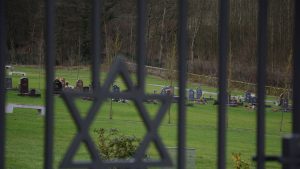Cables show shared Israeli, Arab concerns about Iran
Published November 30, 2010
WASHINGTON — A peek behind the scenes offered by the WikiLeaks cables published this week offer hints into U.S. and regional priorities. The two issues cropping up most often in the Middle East are Iran and Israeli-Arab peace. The cables also offer choice insights into how Americans interact with the locals.
Iran and peace
In private discussions, leaders from Egypt and Dubai both talk about their enmity for Hamas, and they and the Saudi king also warn of the dangers of Iran.
In a classified message from the U.S. Embassy in Cairo to U.S. Secretary of State Condoleezza Rice in January 2008, Omar Suleiman, director of Egyptian General Intelligence, tells Sen. George Voinovich (R-Ohio) that Iran “is supporting Jihad and spoiling peace, and has supported extremists in Egypt previously.” Iranian support of the Egyptian Muslim Brotherhood makes them “our enemy,” Suleiman says.
In a letter to Secretary of State Hillary Clinton in January 2009, the U.S. ambassador in Cairo wrote that after talking to Egyptian Foreign Minister Abdoul Gheit, he is positive that Egyptian President Mubarak sees Iran as Egypt’s “greatest long-term threat, both as it develops a nuclear capability and as it seeks to export its ‘Shia Revolution.’ ” As far as the Israeli-Palestinian conflict, Mubarak is “proud of (Egypt’s) role as intermediary, well aware that they are perhaps the only player that can talk with the Israelis, all Palestinian factions, and (The U.S.). Mubarak hates Hamas, and considers them the same as Egypt’s own Muslim Brotherhood, which he sees as his own most dangerous political threat.”
The Arab leaders in the Persian Gulf share similar sentiments on Iran. A letter sent to Rice from the Dubai consul general in January 2007 states that in a meeting with Nicholas Burns, a State Department undersecretary, the emirate’s leader, Mohammed bin Rashid al Maktoum, “agreed that Iran should not have nuclear weapons, but warned of the dire regional consequences of military action.” In addition, Dubai agreed to cooperate in financial restrictions against Iran, but only if it is done quietly. The Dubai leader also said he hoped for a peace deal because it “would make Hamas everyone’s enemy.”
The Saudi king took his hatred toward Iran a step further, telling John Brennan, Obama’s counterterrorism adviser in Washington in March 2009 that he had just finished a telephone conversation with Iranian Foreign Minister Manouchehr Mottaki and scolded him that that Iran should “stop interfering in Arab affairs.”
“A solution to the Arab/Israeli conflict would be a great achievement, the King said, but Iran would find other ways to cause trouble,” the cable reported. ” ‘Iran’s goal is to cause problems,’ he continued, ‘There is no doubt something unstable about them.’ “
The moving Iran deadline
In a March 2005 cable, U.S. Ambassador to Israel Daniel Kurtzer describes Israel’s fear of Iran’s nuclear weapons program as reaching the “point of no return” when Iran is able to enrich uranium without assistance — a development believed to have been achieved by 2007.
The cables show that Israeli officials saw the diplomatic efforts vis-a-vis Iran as relevant and crucial. However, they expressed their disappointment with the European Union, which according to Prime Minister Ariel Sharon was “too soft,” Kurtzer reported. As to the military option, unlike the strike against Iraq in 1981, hitting Iran would be a much more difficult task, and furthermore would “elicit a strong response from Arab states and the Palestinians, effectively freezing the peace process.”
In a May 2009 meeting between an American congressional delegation and Ehud Barak, Israel’s defense minister, Barak stressed that “no option should be removed from the table when confronting Iran and North Korea.”
Barak also described the Iranians as “chess, not backgammon players,” who will “attempt to avoid any hook to hang accusations on, and look to Pakistan and N. Korea as models to emulate in terms of acquiring nuclear weapons while defying the international community.” Barak also estimated a window between six and 18 months from when the meeting was held in which “stopping Iran from acquiring nuclear weapons might still be viable.” After that, he said, “any military solution would result in unacceptable collateral damage.
He also expressed concern that should Iran develop nuclear capabilities, “other rogue states and/or terrorist groups would not be far behind.” Israeli officials now say the “no return” deadline is sometime in 2012.
Regional concerns
In a meeting between Mossad chief Meir Dagan and then-Sen. Jon Corzine (D-N.J.) on March 13, 2005 in Tel Aviv, Dagan expressed concerns about the fallout from the end of the Iraq War.
“Foreign fighters originating from Tajikistan, Uzbekistan, Syria and Yemen have arrived back in their home countries” after fighting together in Iraq, the Israeli top spy said.
Dagan said that Israel has “no assets in Iraq other than a friendly relationship with the Kurds.” However, he said that Israel has interest in the possible impact the jihadis might have in their home countries, especially in ones where the local governments might not be able to fully respond to the challenge brought by the militants.
In a meeting two years later, in July 2007, with Frances Townsend, President Bush’s top terrorism adviser, Dagan raised alarms about Pakistan’s stability.
”Dagan characterized a Pakistan ruled by radical Islamists with a nuclear arsenal at their disposal as his biggest nightmare,” the cable said. “Al-Qaeda and other ‘Global Jihad’ groups could not be relied upon to behave rationally once in possession of nuclear weapons, said Dagan, as they do not care about the well being of states or their image in the media. ‘We have to keep (President Pervez) Musharaf in power,’ said Dagan.” Musharraf, facing allegations of corruption, resigned in 2008.
A wild wedding
A classified document from the U.S. Embassy in Moscow titled “A Caucasus Wedding” describes the life and culture of Dagestan, a republic in the north Caucasus. The detailed description, replete with references to drunken revelry and the corpulence of the locals, also refers to the members of the Jewish community, their numbers and habits.
A special reference was made to the chief rabbi of Stavropol-Kray, described as “a man who looked like Shamil Basayev,” a Chechen Islamist terrorist, “on his day off — flip-flops, T-shirt, baseball cap, beard — but turned out to be the chief rabbi of Stavropol-Kray. He told us he has 12,000 co-religionists in the province, 8,000 of them in its capital, Pyatigorsk. 70 percent are, like him, Persian-speaking Mountain Jews; the rest are a mixture of Europeans, Georgians and Bukharans.”
Elsewhere, it describes the regional compunction for ethnic identification, and how it seemed to be catching among the diplomats.
“After a couple of hours Dalgat’s convoy returned with Aida, horns honking,” the report says, referring to the groom, Dalgat Makhachev, the son of a lawmaker and oil magnate, Gadzhi Makhachev. “Dalgat and Aida got out of the Rolls and were serenaded into the hall, and into the Makhachev family, by a boys’ chorus lining both sides of the red carpet, dressed in costumes aping medieval Dagestani armor with little shields and swords. The couple’s entry was the signal for the emcee to roll into high gear, and after a few toasts the Piter ‘gypsies’ began their performance. (The next day one of Gadzhi’s houseguests sneered, ‘Some gypsies! The bandleader was certainly Jewish, and the rest of them were blonde.’ There was some truth to this, but at least the two dancing girls appeared to be Roma.)”














